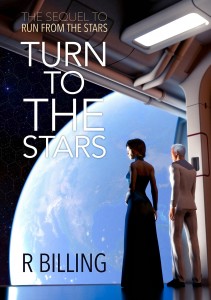This spaceship is the mainstay of the Confederate space fleet.
Paul has created a very good picture of it for the cover of Run from the Stars, which really shows you what standing next to it on a spaceport apron would be like.
This post is about one of the sketches I drew when I was writing the books to fix exactly where all the parts where and how it all joins up. I’m not a proper artist, I’m just an engineering draughtsman, so this doesn’t look nearly as good, but it does how you how the ship works.
If you click on the picture at the top you’ll see one page from the engineering drawing set which shows the arrangement of the major parts.
Important things to note are the way that the undercarriage maingears have to fold flat to fit into the very thin wings, and the enormous track width, almost thirty feet. The width of the track means that it is very forgiving of both bad landings and rough ground handling.
You’ll also see Dr. Mcallister’s signature in the “checked” box. You’ll meet her near the beginning of Turn to the Stars.
This is a list of the numbered parts:
1. Reaction Motors
2. Elevons
3. Waste Heat Radiators
4. Fusion Reactor
5. Orthodynamic Drive
6. Hydrogen Fuel for Fusion Reactor
7. Undercarriage Maingears
8. Plasma Turbines
9. Fin and Rudder
10. Gas Separator (under deck)
11. Emergency Escape Panel
12. Bed cabin
13. Personal effects stowage
14. Weapons Pod
15. Shower and WC
16. Electrical Equipment Room (gearspace)
17. Store room
18. Galley
19. Day Cabin
20. Fixed Teleportal
21. Pressure Suit Stowage
22. Airlock
23. Flight Deck
24. Undercarriage Nosegear
25. External Lights and Sensors Dome
26. Slot Antenna
27. Belly Motors
28. Lock-on Port
29. Docking Probe
30. External Services Connector
31. Fire Extinguishers and Smoke Masks
32. Reaction Mass Water Tank (under deck)
33. Accumulators (under deck)


